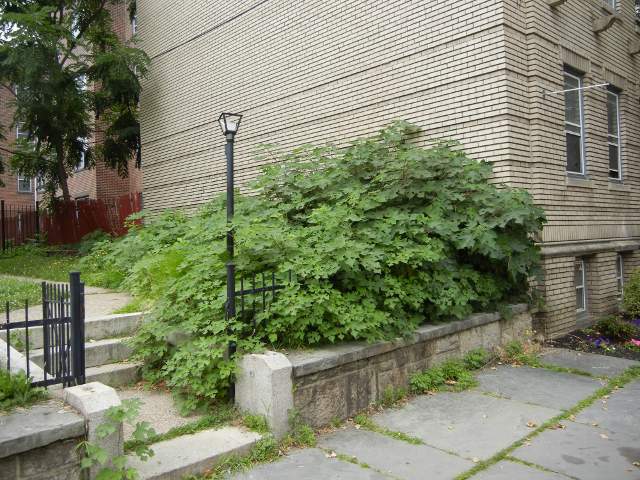Paper Mulberry Thicket, 41st Street, Philadelphia in album Philadelphia
In Albums: Philadelphia

Jun 27th, 2011, by Alex Zorach
This photo shows a thicket of paper mulberry trees, on the west side of 41st street in West Philadelphia, the block between Chester and Baltimore avenues.
This photo shows various signs of obvious neglect. The paper mulberry is usually a weed plant, and is often considered an invasive species. This photo shows not a single tree, but a large thicket of many trees. The lamp post shows broken glass and no lamp, and another paper mulberry tree is coming up in front of the stone wall on the left, along the sidewalk.
Even though this area is unmaintained, I found an odd sort of beauty in it. The weedy thicket of growth is lush and green, and I find the old flagstones in the sidewalk beautiful as well.
One thing that strikes me about this photo and this area as a whole is the degree of neglect, in spite of the unusually large amount of open space and beauty in the infrastructure of this area. Philadelphia as a whole is a relatively crowded city, and even in the slightly more spacious West Philadelphia, yards as large as this one are very rare, and land values for properties with this much space are often astronomical. When I see a property like this, located in a prime location near the SEPTA trolley portal, UPenn's campus, and in walking distance of numerous businesses, I wonder who owns it, and what would need to happen for them to either maintaining it better or allow someone to maintain it better. I also wonder what could be better done to promote or facilitate better use of space and property like this one. I live a block from here, and have no space for a garden...I'd love to grow a garden in this space. Or, I'd love to see it planted with native trees, or at least a weedy thicket of native plants, instead of seeing it dominated by a single species of non-native plant.